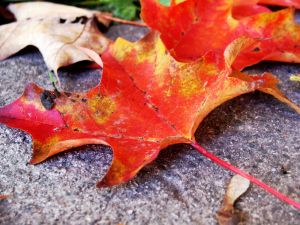This Year’s Black Is Yellow and Red: Why Trees Change Color
 As I have mentioned recently, the trees are starting to change color. If you happen to live in a part of the world that has the traditional “Changing of the Leaves”, you may have noticed that the trees ran out in the middle of the night and bought a whole new wardrobe. And if you pay very close attention, you may have noticed that between the beginning of fall and the end of fall, the trees changes colors not once, but twice.
As I have mentioned recently, the trees are starting to change color. If you happen to live in a part of the world that has the traditional “Changing of the Leaves”, you may have noticed that the trees ran out in the middle of the night and bought a whole new wardrobe. And if you pay very close attention, you may have noticed that between the beginning of fall and the end of fall, the trees changes colors not once, but twice.
Which would explain why they eventually lose their leaves because all that wardrobe changing means that they maxed out their credit cards and the leaf repo man came and took their clothes away. Hmm…
Back on topic.
Leaves change color in two stages. The first stage is the yellow and orange stage. The leaves on a tree will typically turn yellow or orange first. This because, in reality, all leaves are really yellow or orange all the time.
The yellow dyes are xanthophylls and the orange are carotenoids. Chlorophyll covers these dyes so that for most of the summer the leaves look green. The plant must continually produce the chlorophyll in order to stay fashionably green.
But then the nights get longer and lonlier and the plant finally says, “To hell with all this green stuff. I just want to be me!”. The plant slows its production of chlorophyll to the point where it no longer produces enough to hide behind and the yellows and oranges are slowly revealed.
As the slowing of the chlorophyll occurs, the plant begins to produce red pigments called anthocyanins. And the leaves will then go from yellow and orange to a red for the second act of the fall display.
Now here is the kicker, all of these pigments, green, yellow, orange and red are affected by cold. If an area gets an early frost, all the dyes will break down and there is only a pathetic excuse for a fall display. In the case of frost or freeze, the only pigment that doesn’t break down is the deep down brown pigments. Yuck. Brown is just so 1990s.
Sunlight will also break down the green, yellow and orange pigments but will intensify the red pigments, but if an area stays overcast before the tree kicks into making the red pigment, the red color will be even more brilliant.
A magical combination of cool and overcast early Fall and a bright but not too cold late Fall will make for a the best foliage display.
The environmental conditions and native tree species in some areas also influence the whole process, green to red, causing some places to have fly by fall fashion shows while other areas can enjoy the whole process over a much longer period of time.
Confused yet?
Don’t feel bad if you are. It is confusing. Even scientists have been spending a few decades trying to figure it all out.
In the end, a lot of money was probably spent on figuring out why trees change their look more than Madonna. I think I would rather have had someone send me the check for that research so that I could go research the leaves changing color from a cabin with a hottub. I always think research is best done from a hottub.
Image by Paul Joseph

Pingback: How Trees Get Naked - Leaf Senescence And Why Leaves Fall Off A Tree